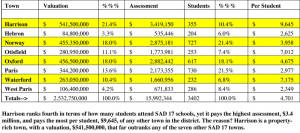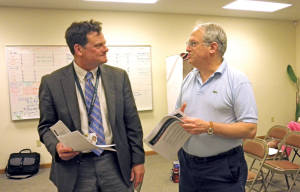Harrison town leaders seek school budget relief
By Gail Geraghty
Staff Writer

Harrison ranks fourth in terms of school spending, yet it pays the highest assessment, $3.4 million, and pays the most per student, $9,645, of any other town in the SAD 17 School District. The reason? Harrison is a property-rich town, with a valuation, $541,500,000, that far outranks any of the seven other district towns.
HARRISON — Harrison Selectmen had the chance to vent their frustrations about the high cost of membership in the SAD 17 School District, at a recent workshop with SAD 17 School Supt. Rick Colpitts.
But it wasn’t all just talk — selectmen consider the matter so serious, that they directed Town Manager George “Bud†Finch to write the governor and state education commissioner, asking them to address the “serious inequity and unfairness†that the education funding formula has on a property-rich, population-small town like Harrison.
Harrison pays more per student, $9,645, than any of the district’s seven other towns, because it has the highest valuation, $541.5 million. Educational assessments account for 65% of the overall budget, and have increased by 12.5% over the past two years.
“As long as the state continues to use a formula of cost per student based on the total school budget divided by the number of students in the school, it will always appear to be a fair funding formula,†said Finch, when in fact the formula forces Harrison to shoulder a disproportionate 21.5% of SAD 17’s $16 million budget for the upcoming year.
“It is critical to the future of Harrison that we pursue action during the legislative session following the election in November — and it needs to start now,†he wrote in his April 6 weekly update.

A WILLING LISTENER — SAD 17 School Supt. Richard Colpitts listens to Harrison Selectman Matthew Frank discuss his concerns over school spending at a recent workshop.
At the workshop with Colpitts, held at the town office on March 22, Finch was blunt. “The ability of the taxpayer to fund the budget has reached a breaking point,†he told Colpitts. The proposed municipal budget would mean a 9-cent increase in the mill rate, but when education and county budgets are factored in, that increase jumps to 33 cents.
“There is really nothing left to cut without impacting services,†on the municipal side, Finch said. “We pay 21 percent of the (SAD 17) budget, but we only have 10 percent of the students.†Harrison’s $9,645 cost per student is just over twice the $4,701average cost per student for the other SAD 17 towns.
It’s getting so that some people won’t be able to afford living in Harrison, he said, if the funding formula doesn’t change. Year-round Harrison property owners aren’t rich, he noted; a whopping 75% of Harrison’s student population of 355 students qualify for and receive free and reduced lunch at school.
To add insult to injury, in the mind of some selectmen, is the fact that Harrison, even though it pays the most, only has two representatives on the 22-member SAD 17 Board of Directors. The towns of Norway, Oxford and Paris each have four representatives — and also share the tax burden with a sizable business sector, which Harrison does not have.
“We pay the most bucks. We should have the most say,†said Selectman Richard St. John.
But Colpitts said the state sets the rules, as well, for how many representatives from each town can be on school boards. “It comes down to how many voters you have in your district.†Colpitts listened attentively to Finch and each of the selectmen’s concerns, but said “short of changing the statutes,†nothing can be done.
“Ninety-five percent of our taxes come from homeowners. We don’t have a commercial tax base,†Finch said. It’s frustrating, he said, to make productivity improvements and defer maintenance on municipal services, just to meet the growing demands for funding education. It’s especially frustrating, in light of the current trend in Harrison toward a decline in student population.
“I hate to ramble on at times about the budget, but I do believe it is critical for people to understand that 70% of their tax dollars go towards education,†Finch wrote in one of his most recent weekly updates. “For Harrison, our cost per students from those local dollars causes a serious inequality and unfairness.â€
Colpitts, for his part, outlined the many ways he’s tried to hold the line with the current school budget of around $35 million. Nevertheless, there’s been an increase of 6.03 percent or $964,612 in local assessments, required in order to avoid cuts to staff and programs, he said.

